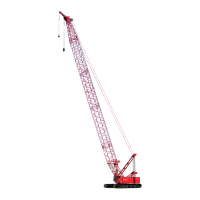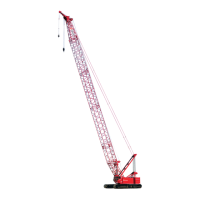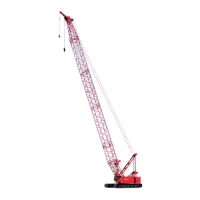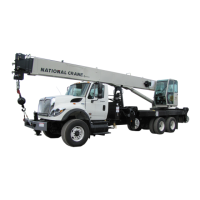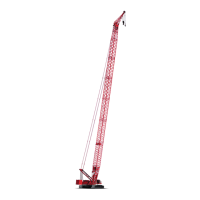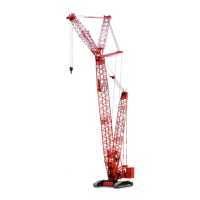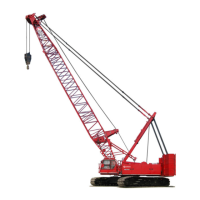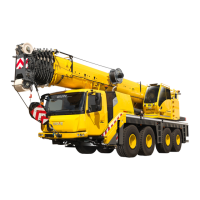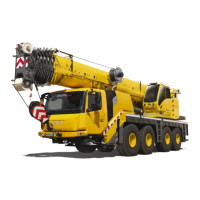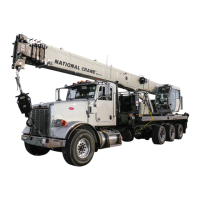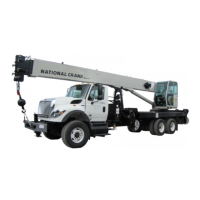
Do you have a question about the Manitowoc 1400A and is the answer not in the manual?
| Brand | Manitowoc |
|---|---|
| Model | 1400A |
| Category | Construction Equipment |
| Language | English |
Suggestions for analyzing and correcting problems, cleanliness, and parts handling.
General information, environmental conditions, and dynamic shock loads for wire rope.
Hydraulic system maintenance precautions, label parts, and welding precautions.
Components of the hydraulic system including pump, valves, tank, and controllers.
Procedures for adjusting relief valves to protect components and ensure proper pressure and flow.
Description, maintenance, and troubleshooting for the hoist system.
Description, theory of operation, and maintenance for the swing system.
Components of the outrigger beam assembly, including beams and stabilizer cylinders.
Procedure for tensioning cables for outrigger beam extension and retraction.
Recommendations for lubricants, including chassis grease, hydraulic oil, and wire rope lubricant.
Guidelines for using petroleum-based fluids for low-temperature service.
Minimum requirements for truck frame, axle ratings, wheelbase, and section modulus.
Determining truck frame suitability based on section modulus and resistance to bending moment.
Procedures for positioning and mounting the crane onto the truck frame.
Information on safety compact discs and general safety precautions.
Description of parts of a National Crane as shown in diagrams.
Importance of cleanliness for machine life, cleaning procedures for parts and compartments.
Guidelines for safely removing and installing heavy parts, using lifting equipment.
Procedures for removing, cleaning, inspecting, and installing antifriction bearings.
Method for heating bearings for expansion during installation.
Daily and monthly inspection procedures for hydraulic components like hoses and fittings.
Inspection guidelines for valves and manifolds, checking for leaks and damage.
Procedures for cleaning, charging, and maintaining batteries.
Visual inspection of electrical harnesses, cables, and connectors for damage.
Procedure for applying medium strength Loctite adhesive/sealant, including preparation and curing.
Tables listing torque values for ASME standard and metric fasteners.
Inspection, replacement, and maintenance guidelines for wire rope.
Factors affecting wire rope life due to environmental hostility.
Examples of loading conditions that shorten wire rope life expectancy.
Daily visual inspection to monitor rope degradation and identify damages.
Annual inspection of wire rope, including diameter reduction and end connections.
Periodic inspection guidelines for boom extension and retraction cables.
Description of the hydraulic system, components, supply, and return circuits.
Descriptive information for all hydraulic valves used on the crane.
Procedures for adjusting relief valves for component protection and system performance.
Description, removal, installation, and startup procedures for the hydraulic pump.
Chart listing malfunctions, possible causes, and solutions for hydraulic system issues.
Precautions before starting adjustments and repairs on the crane.
Importance of preventing contaminants in the hydraulic system and cleaning procedures.
Details on the axial piston pump's pressure compensation, flow rates, and standby pressure.
Description of the main control valve's sections and their functions in controlling hoist, lift, and telescope.
Description of the swing control valve, its location, and operation for turret rotation.
Function of the RCL dump manifold in disabling crane functions during tipping conditions.
Description of outrigger manifolds controlling extend/retract and component selection.
Importance of adjusting valves for component protection and proper pressure/flow.
Procedures for checking and adjusting relief valves by stalling circuits.
Procedure to set the hoist hydraulic circuit relief valve on the main control valve.
Procedure to set boom up and boom down relief valves on the main control valve.
Procedure to adjust the flow control relief valve for outrigger extension.
Procedure to adjust the extend relief valve on the front outrigger port block.
Procedure to adjust the retract relief valve on the front outrigger port block.
Steps for removing the filter element from the hydraulic oil filter housing.
Steps for installing a new filter element into the hydraulic oil filter bowl.
Procedures for cleaning and inspecting the hydraulic oil cooler for efficient operation.
Inspection and troubleshooting for directional control valves, including spool binding and leakage.
Procedures for removal, installation, and functional check of the main control valve.
Procedure to check the RCL dump valve function to disable overload functions.
Details on the hydraulic pump's power requirements and mounting.
Procedure for removing the hydraulic pump, including draining the tank and disconnecting lines.
Steps for installing the hydraulic pump, including lubrication and mounting.
Procedures for initial installation of the hydraulic pump, including mounting and drive line.
Startup procedure for a newly installed or replaced hydraulic pump to prevent damage.
Troubleshooting steps for lack of hydraulic oil flow, including low level, restrictions, and pump issues.
Troubleshooting steps for erratic or loose swing movement in the Glide Swing System.
Troubleshooting steps when the swing function does not operate in the Glide Swing System.
Troubleshooting steps for erratic or loose swing movement in the Standard System.
Troubleshooting steps when the swing function does not operate in the Standard System.
Overview of the truck and crane electrical systems, including wiring and control circuits.
Warning against jump starting due to sensitive computer systems and recommended charging procedures.
Guidelines for charging batteries, including slow charging and avoiding frozen batteries.
Electrical system maintenance includes troubleshooting and replacement of damaged components.
Troubleshooting common electrical issues with the crane's electrical swivel.
Identifying and resolving electrical problems caused by loose or corroded connections.
Disables truck ignition when crane or radio remote starts the engine.
Powers the oil cooler fan when the oil temperature switch closes.
Switches throttle control between truck and crane, disabled by radio remote.
Energizes the engine starter circuit from crane cab ignition or radio remote.
Disables crane ignition switch when the truck is running.
Provides power for ground level outrigger control, disabled when crane function power switch is energized.
Function disabled by RCL/ATB solenoids when an impending tipping condition occurs.
Enables all crane functions when energized by the crane manifold solenoid.
Applies the swing brake when energized by the crane manifold solenoid.
Controls front outrigger components, SFO, extend/retract, and hydraulic flow.
Controls selection of rear outrigger components.
Description of the four section boom, its cylinder, and cable routing for extension/retraction.
Description of the five section boom, its cylinder, and cable routing for extension/retraction.
Procedure for lubricating internal cable sheaves using a special grease gun tip.
Procedure for tensioning cables to balance preload and ensure proper sequencing of boom sections.
Two methods for disassembling the boom: conventional and removing extend cylinder for service.
Measuring the inside width of the outer boom section at the front and back.
Measuring the outside width of the inner boom section at each side pad location.
Measuring the thickness of the left and right side wear pads.
Procedure for setting up cable tensioning with the boom in a horizontal position.
Specific sequences for tightening cables for five-section and four-section booms.
Procedure for balancing 321 retract and 123 synchronizing cables for extension and retraction.
Procedure for balancing 321 retract and 123 synchronizing cables for extension and retraction.
Procedure for balancing 234 extend and 432 retract cables for extension and retraction.
Procedure for balancing 321 retract and 123 extend cables for extension and retraction.
Procedure for balancing 234 extend and 432 retract cables for extension and retraction.
Components of the 1400A hoist: motor control valve, hydraulic motor, brake, and planetary gear sets.
Daily inspection for oil leaks, loose bolts, and worn cable; gearbox and brake oil checks.
Recommended start-up procedure, especially in cold temperatures, to warm up the hydraulic system.
Steps for installing the hoist onto the back of the boom.
Integration of Drum Rotation Indicator and Minimum Wrap Indicator into the Hoist Monitoring System.
Troubleshooting steps for hoist issues, including circuit breaker resets and general problems.
Inspection and replacement of hydraulic hoses, including routing through anti-chafing sleeves.
Steps for removing the Drum Rotation Indicator (DRI) unit from the hoist.
Procedure for installing the DRI unit, including shaft assembly and positioning.
Troubleshooting checks for Series 'A' units, including in-line fuse checks.
Instructions for resetting circuit breakers on Series 'B' units with integrated protection circuitry.
Steps to disassemble the hoist, inspect, and replace worn parts.
Procedures for removing, inspecting, and reinstalling brake components, including friction discs and stator plates.
Troubleshooting steps for issues related to holding load, including back pressure and brake discs.
Troubleshooting steps when the hoist cannot lift the load properly, relating to relief valve and load weight.
Troubleshooting steps when the hoist does not lower the load, related to brake valve and cartridge.
Troubleshooting oil leaks from the motor shaft seal or brake piston seals.
Purpose of the swing system to allow 360-degree rotation of the crane turret.
Explanation of how the swing system operates using hydraulic remote control, valve, motor, and brake.
How hydraulic power is supplied to the swing drive by the PTO driven axial piston pump.
Hydraulic power supply for the swing brake release and operation of the brake for parking and glide-swing mode.
Procedures for disassembling and assembling the swing gearbox and brake.
List of tools required for swing gearbox and brake disassembly and assembly.
List of parts needed for rebuilding the swing gearbox and brake.
Detailed steps for disassembling the swing gearbox and brake assembly.
Detailed steps for disassembling the swing brake, including removing springs, discs, and stator plates.
General maintenance for the swing bearing, emphasizing critical points for safe operation.
Mandatory inspection and re-torquing of swing bearing and T-box attaching bolts.
Procedure to measure swing bearing internal clearance using a dial indicator.
Steps for removing the swing bearing, including boom and turret positioning and component disconnection.
Purpose of the two-section outriggers for crane stability.
Components of the outrigger beam assembly, including beams, cylinders, and hardware.
Initial step for removal: ensuring the stabilizer is retracted and the float is removed.
Tagging and removing top wear pads and shims from the outrigger beam stabilizer end.
Extending the outrigger beam slightly to attach a lifting strap.
Disconnecting hydraulic lines from the base of the extend cylinder.
Installing stabilizer hydraulic tubes into the 2ND section beam.
Installing wear rings into the stabilizer leg.
Inserting the stabilizer cylinder into the stabilizer tube.
Sliding the retainer plate under the stabilizer cylinder butt end.
Installing the lock plate and capscrews for the stabilizer cylinder.
Installing the holding valve on the stabilizer cylinder.
Connecting hydraulic fittings and tubes to the holding valve.
Installing wear pads and shims onto the 2ND section beam.
Positioning the 1ST section beam on blocking for assembly.
Installing side wear pads and shims between boom sections.
Assembling cable sheave, shaft, and hose reels onto the extend cylinder.
Inserting the extend cylinder into the outrigger assembly, being careful of cables and hoses.
Lifting the cylinder for cable anchor access and installing fittings.
Assembling the cable stop into the anchor and installing it in the 2ND section beam.
Connecting fittings for stabilizer cylinder hydraulic tubes to the cable anchor.
Routing cables through the sheave hole on the bottom of the 2ND beam section.
Lowering the cylinder trunnion into the pocket on the 1ST section beam.
Installing wear pads and shims on the 1ST-2ND section beam assembly.
Connecting cables, fittings, and hoses to the cylinder butt plate.
Sliding the beam assembly into the outrigger box, guiding cables and installing anchor nuts.
Pushing the beam assembly into the main outrigger box until the cylinder butt plate reaches the end.
Reinstalling hydraulic lines and holding valve on the extend cylinder.
Installing side and bottom wear pads and shims.
Procedure for cycling outriggers and checking beam position at full retraction.
Identification and function of string potentiometers used in the OMS for outrigger beam position.
Steps for removing the string potentiometer, including disconnecting the spring clip and electrical connector.
Steps for installing the string potentiometer, including mounting and connecting electrical components.
Procedure for calibrating string potentiometers through the crane's RCL.
Guidelines for lubrication procedures, service intervals, and environmental considerations.
Procedures for proper disposal of waste fluids and handling of environmentally harmful substances.
Recommendations for lubricants, including chassis grease, hydraulic oil, and wire rope lubricant.
Use of petroleum-based fluids for low-temperature service.
Importance of selecting proper hydraulic oil based on viscosity and anti-wear additives.
Factory fill hydraulic oil is ISO grade 46/68, acceptable for temperatures above -9°C (15°F).
Inspection of hydraulic oil condition and filters based on operating environment and frequency.
Checking and maintaining the hydraulic oil level using the sight gauge.
Factory fill hydraulic oil is ISO grade 46/68, acceptable for temperatures above -9°C (15°F).
Wire rope requires scheduled maintenance for proper function and protection.
Various methods of applying wire rope lubricant like bath, dripping, pouring, swabbing, painting, and pressure spray.
Antifreeze/Coolant (for Cab Heater) specifications.
Extreme Pressure Multipurpose Grease specifications.
GL-5 Gear Lubricant specifications.
Hydraulic Oil specifications.
Open Gear Lubricant specifications.
Extreme Pressure Gear Lubricant specifications.
Wire Rope Lubricant specifications.
Engine Oil specifications.
TES295 Compliant Fluid specifications.
Recommended lubricant for hydraulic oil reservoir and fill check procedure.
Procedure for changing or cleaning the hydraulic oil filter.
Cleaning the magnetic plug in the hydraulic oil reservoir.
Cleaning the breather on the hydraulic oil reservoir.
Lubrication procedure for boom, jib, block, and rooster sheaves using EP-MPG grease.
Lubrication procedure for boom pivot pins using EP-MPG grease.
Lubrication procedure for lift cylinder pins using EP-MPG grease.
Lubrication procedure for turntable bearings using EP-MPG grease.
Recommended lubricant for boom lubrication inner wear pads is EP-3MG grease.
Procedure for lubricating boom side and bottom wear pads using EP-3MG grease.
Checking and changing hoist brake oil.
Procedure to check hoist brake oil level by inspecting the oil level in the inspection hole.
Procedure to drain and add new hoist brake oil, including fill capacity and temperature range.
Procedure for draining the hoist gearbox oil.
Procedure for filling the hoist gearbox with new gear lube.
Wire rope requires scheduled maintenance for proper function and protection.
Various methods of applying wire rope lubricant like bath, dripping, pouring, swabbing, painting, and pressure spray.
Information on preventing premature corrosion of cranes through proper maintenance and care.
Recommendations for inspecting and repairing scratches and marks to prevent corrosion.
Information for proper mounting and initial check out of the crane.
Minimum requirements for truck frame, axle ratings, wheelbase, and section modulus.
Determining truck frame suitability based on section modulus and resistance to bending moment.
Summary of mounting and truck requirements based on 85% stability factor.
Describes the working area achievable with the single front outrigger.
Specifies the required GAWR for the front axle of the truck.
Specifies the required GAWR for the rear axle of the truck.
Specifies the required GVWR for the truck.
Determines WB, CT, and CA requirements based on mounting configuration and boom length.
Estimated bare chassis weight required for stability before crane installation.
Requirements for PTO horsepower and torque for the hydraulic pump.
Details on direct mounting pump installations to the PTO, including lubrication.
Combinations of PTO ratio and engine speed for proper pump shaft speed.
Ensuring the hydraulic pump is installed to rotate in the correct direction.
Measurement of cross-sectional area determining frame rigidity and its relation to strength.
Describes the working area achievable with the single front outrigger.
Specifies the required GAWR for the front axle of the truck.
Specifies the required GAWR for the rear axle of the truck.
Specifies the required GVWR for the truck.
Determines WB, CT, and CA requirements based on mounting configuration and boom length.
Estimated bare chassis weight required for stability before crane installation.
Selecting the appropriate PTO according to PTO Requirements Section.
Installing the PTO and its shifting mechanism per manufacturer's instructions.
Mounting the pump directly to the PTO if integral flanges are used.
Locating the pump and drive line for clearance and proper angles.
Planning pump mount and drive line location for adequate clearance and line routing.
Securely installing the pump mounting bracket to the truck frame.
Verifying pump rotation and removing dust covers before connecting lines.
Determining frame strength and reinforcement needs using Section Modulus Tables.
Positioning the crane assembly on the truck frame based on information from Positioning the Crane On the Truck section.
Locating the upper mounting plates on the T-box frame for crane attachment.
Welding the upper mounting plates to the T-box frame on all four sides.
Bolting the anchor bar to the upper mounting plate finger tight.
Bolting the lower mounting plate to the anchor bar finger tight.
Drilling bolt holes through the truck frame using the lower mounting plate as a guide.
Positioning the crane assembly on the truck frame as determined by previous information.
Locating the upper mounting plates on the T-box frame for crane attachment.
Welding the upper mounting plates to the T-box frame on all four sides.
Bolting the anchor bar to the upper mounting plate finger tight.
Bolting the lower mounting plate to the anchor bar finger tight.
Drilling bolt holes through the truck frame using the lower mounting plate to locate bolt holes.
Routing the harness away from potential damage from drive line and exhaust system.
Connecting accessory and ignition wires to the truck's ignition switch.
Routing wires 5 and 51 to the truck battery, ensuring they are not pinched or cut.
Connecting the start wire to the starter solenoid on the engine side of the firewall.
Ensuring the return line gate valve is open before starting the pump.
Description of the hydraulic system pressure source and flow rates for different functions.
Adjusting throttle for engine RPM and PTO ratio to achieve proper pump shaft speed.
Measuring the overall height for informing the driver of clearance limitations.
Requirement to complete the initial crane run-in procedure before stability testing.
Engaging the PTO and performing initial crane functions for purging air and checking operation.
Operating control valves slowly to cycle cylinders and check boom/outrigger movement.
Verifying that outrigger and boom movements match indicated directions on controls.
Adding oil to the reservoir to prevent air from re-entering the system.
Setting throttle based on engine RPM and PTO ratio for proper pump shaft speed.
Stowing the crane with retracted outriggers and checking oil level after initial run-in.
Performing the lift and stability test after initial run-in and stowing the crane.
Checking torque on bearings, mounting, and cable clamp bolts after testing.
Placing the test unit on a firm, level surface with cribbing under outrigger floats if needed.
Raising and leveling the machine on outriggers with tires clear of the ground.
Understanding load limitations based on stability and the need to lift 1.176 times the rated load.
Performing stability tests with two loads to ensure stability over sides and rear of the machine.
Requirements for hydraulic system pressure, flow rates, and reservoir capacity for crane functions.
Standard wire cable specifications and nominal breaking strength for the hoist system.
Operating speeds for rotation, boom, outrigger beam, and their tolerances.
Hydraulic requirements and minimum evacuation time for the optional air conditioner.
Operating speed for 360° rotation with tolerance.
Operating speed for boom up movement with tolerance.
Operating speed for boom down movement with tolerance.
Operating speed for boom extend with tolerance for specified boom lengths.
Operating speed for boom retract with tolerance for specified boom lengths.
Operating speed for boom extend with tolerance for specified boom lengths.
Operating speed for boom retract with tolerance for specified boom lengths.
Operating speed for outrigger beam extension with tolerance.
Operating speed for outrigger beam retraction with tolerance.
